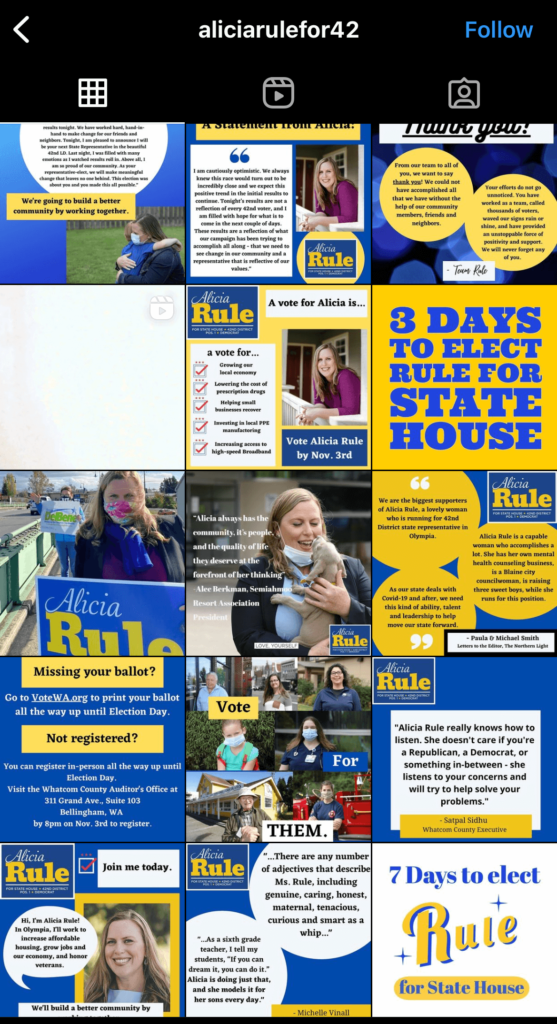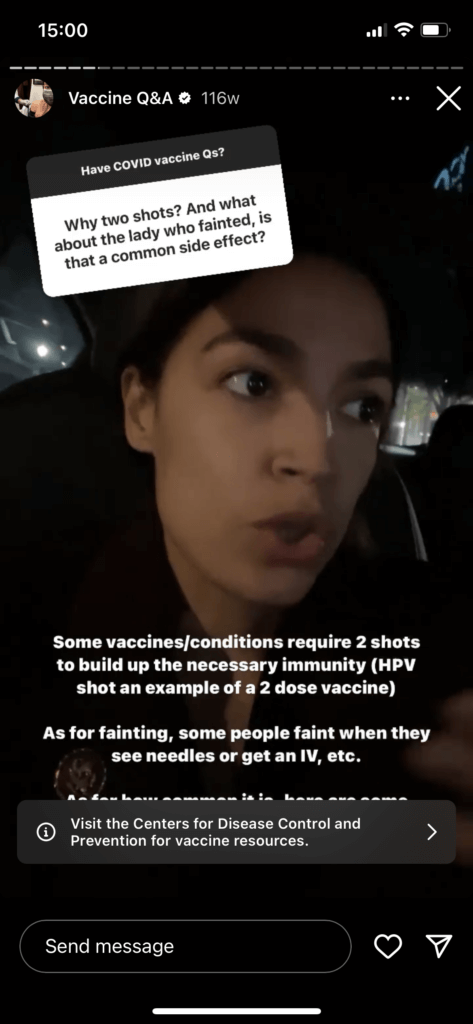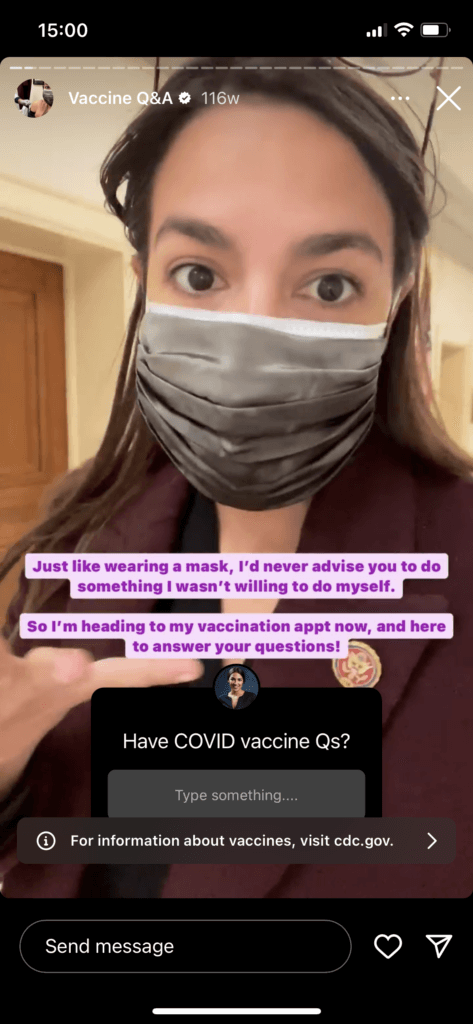Instagram Guide
About 40% of adults in the U.S. are on Instagram, and the bulk of those users are young adults (40 and under). That’s less than YouTube and Facebook, which have 80 and 70 percent of U.S. adults respectively. Nonetheless, Instagram is a highly popular social media platform. It has helped political campaigns spread their messages, especially to younger voters who are becoming a more powerful voting block in the U.S.
Instagram can be a fun way of reaching voters where they are. The photo and video based nature makes it an accessible way for campaigns to distill information and humanize their candidates. Instagram’s acquisition by Meta also makes it a very available tool to use for online voter engagement. Since your campaign is already on Facebook (and if it isn’t, it should be), you should join Instagram to increase your social media’s reach.
Photos and videos or “Reels,” as Instagram calls them, are effective voter engagement tools because they immediately catch people’s eyes in a way only words cannot. Once they are seen, people will read captions for additional information. But that initial entry must be engaging or else users will scroll right past.
Instagram is the dominant social media platform for Gen Z (aka Zoomers, people ages 18 to 25) and Millennials (people ages 26 to 42), though Gen X (people ages 43 to 58 approximately) internet users are the fastest growing group of new users on the site. Many Zoomers cite Instagram as their favorite social media platform, ranking it above TikTok, another hugely popular site among young people.
Perhaps different from other social media platforms used in the U.S., Instagram has more women than men active on the site. 55% of active Instagram users in the U.S. identify as women, while 44% of users identify as men. On Twitter, for example, men out represent women, and LinkedIn has a somewhat even gender split. Important to note that although Instagram has added nonbinary gender option, not much data has been collected including that demographic in usage reports.
If you want to take a more creative approach to how your campaign engages voters and engage young people, Instagram is the way to go. Don’t discount young people’s enthusiasm either. They’re great communicators that can spread messages like wildfire–look at how President Joe Biden has regularly engaged TikTok celebrities and influencers this past year.
Though social media reaches a lot of people, it should not be considered integral to campaigning. It cannot replace tried-and-true methods of mail and doorknocking. The time given to social media needs is relative to the size of your campaign. We say this because candidates and campaigns have real constraints on time and energy, so you have to focus where you need to in order to win – which sometimes doesn’t mean getting a lot of followers on your social media accounts.
Facebook should be a priority out of all the social networking sites, but if you can afford it, with budgets between $25 and $100k for example, then add Instagram and Twitter to boost your overall campaign message. Between $100 and $500k, expend real resources and staff time to develop and execute campaign-winning goals. If your race’s budget is above $500,000, hire somebody.
We have seen too many candidates and campaign managers spend too much time online! Updating your feed is NOT the same as digital organizing. To avoid this enticing trap, allocate resources, develop a plan and stick to it!
Instagram’s primary use for people is lifestyle showcasing. The goals are the same as for Facebook, with the added element that it’s very much more you oriented–as in, your (candidate’s) face in front of the camera. So it’s important to balance political posts with showing that the candidate is a real person. What does the candidate do when not dialing for dollars? What is the candidate’s favorite park in your district? Political campaign accounts are considered the most annoying and artificial. Instagram should be used to make the campaign and candidate seem more approachable to dispel users’ distrust and skepticism.
Although candidates need to be front and center on instagram, just posting text or headshots won’t get you many followers or likes, and thereby won’t inform users of the campaign. Informational graphics and photos or videos of the candidate (often front-facing) do well on the platform. We define informational graphics as tailor-made and branded posts with text distilling information.The posts with the most engagement are ones with recognized branding or theme, showcase the product (in this case, the candidate) in action, often as Reels, and are several photos in one post, called a carousel.

Best practices for posting:
- Be a source for news relevant to the district/community–effectively, the people following you want to be kept apprised of your campaign and how it interacts with the community at large. Your Instagram page could be like a bulletin board of timely information.
- Humanize the candidate–there is much disillusionment in politics and political figures. Have the candidate be personal. If the candidate isn’t willing or ready to be on camera, have a team or community member speak on your candidate’s behalf.
- Posts should contain some type of story–Instagram is entertainment, and your campaign is competing against a lot of captivating content creators.
- Reels gain more traction than photos/stills, but also vary your posts. If your campaign posts still photos, be sure to take advantage of the carousel feature. These tend to reappear frequently on users’ feeds more often. Instagram has a notoriously finicky algorithm, and carousels have been found to beat it.
- Utilize Instagram Stories. They’re a great way to create something simple and tappable/clickable, sequential, and are time sensitive since they’re only available for 24 hours. After 24 hours, the posts can be archived on your campaign’s Instagram profile page, and that’s also an opportunity to convey information.
If you have photos, more is best; otherwise, Reels
Instagram gave the option for users to add more than one photo (up to 10, specifically) in a post in around 2017. Back then, only two to three percent of posts worldwide used the feature. By now, approximately 20 percent of content on the platform are carousel posts. And the highest performing posts are often carousels, despite overall Feed posts engagement decreasing. Carousels have an engagement rate of 1.92 and go over 2 percent when all ten slides are used. Videos have 1.45%, and solo image posts have 1.74%.
Carousel posts get a lot of engagement for a simple reason: people like scrolling. They also show up on feeds more frequently, each time with a different image or video slide shown. Global studies show engagement with carousels drop off at around the third slide, but pick up around the eighth, or towards the last in the bunch. Therefore, if you do make carousel posts, go with 8 to 10 posts.
Reels are increasingly popular. Instagram now considers all video posts, no matter how long or short, as Reels, and the algorithm puts them on feeds and the explore/discovery page more often than carousels. Similar to carousel posts, the shift to Reels parallels changes in social media habits emphasizing scrolling and autoplay. The same best practices for image posts apply to Reels too, with more emphasis on storytelling. Reels are a fantastic place to have th4e candidate speak directly to the camera (aka audience) with an important update or commenting on a current event. Think of it like a mini movie clip, or a filmed polished speech, depending on what the campaign showcases. Remember to use captions on all videos–a lot of people watch videos without their sound off, and it also provides more accessibility for hard of hearing people or people with auditory processing difficulties.
Engaging followers on Instagram is slightly different from Facebook. It was the first platform to allow users to hide likes received and limit comments, and it added the stories feature (copied from Snapchat) before Facebook.
A straightforward way of engaging followers is through Instagram Stories. Posting polls, questions, RSVP links, CTAs, and more give followers something to respond to without requiring them to put much energy into it. Your campaign also gains valuable glimpses at what entices your supporters.


In all your posts, regardless if it’s a Story or post, captions are important. It can be a space to contextualize your posts, strengthen your brand by wielding its narrative arc/style, and make actionable asks. People DO read captions, and providing additional ways of engagement with content is also good accessibility practice.
Just as it is with Facebook, tagging and allowing resharing/reposting of your posts and stories engages followers and amplifies your message. If there are other people in your posts, and they consent, make sure you tag them.
Instagram, like all social media sites, is constantly evolving, and every cycle we see candidates come up with new ways to engage their audience and elevate their online presence. As political media evolves, we are focusing on implementing new strategies and tactics. If your political project needs compelling media with innovative strategies – give us a call at 206-423-0120 or send us an email at connect@cn4partners.com and let’s figure out how CN4 can partner with you and help you win.